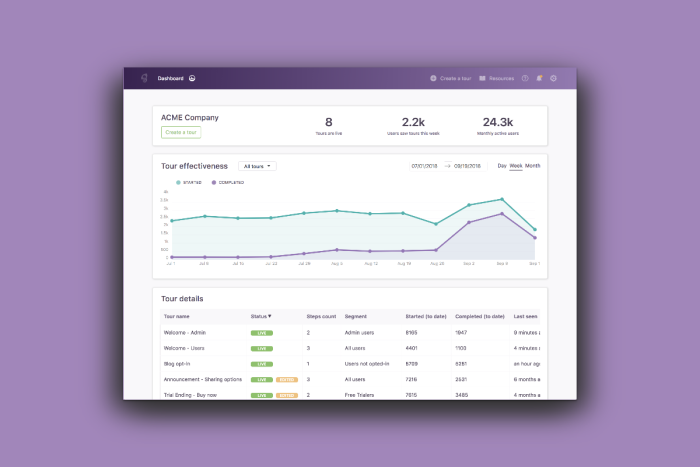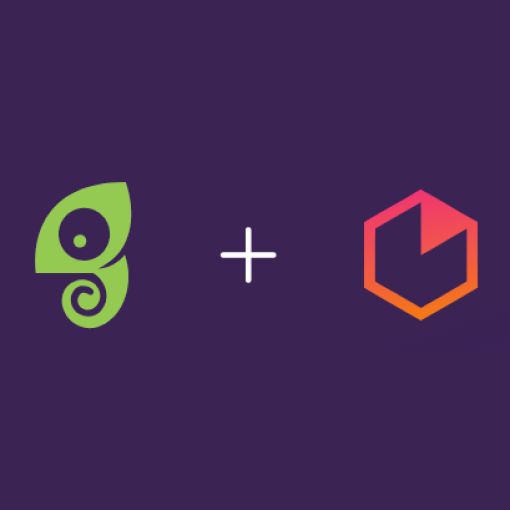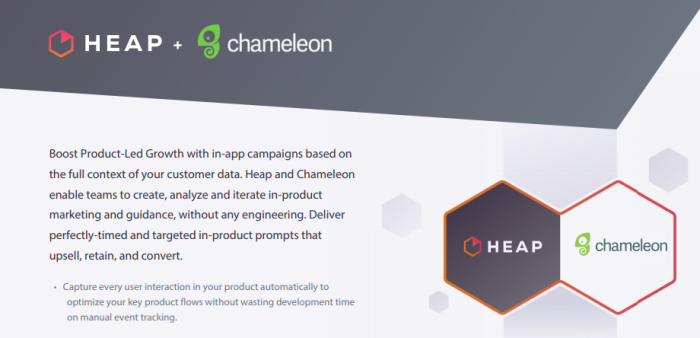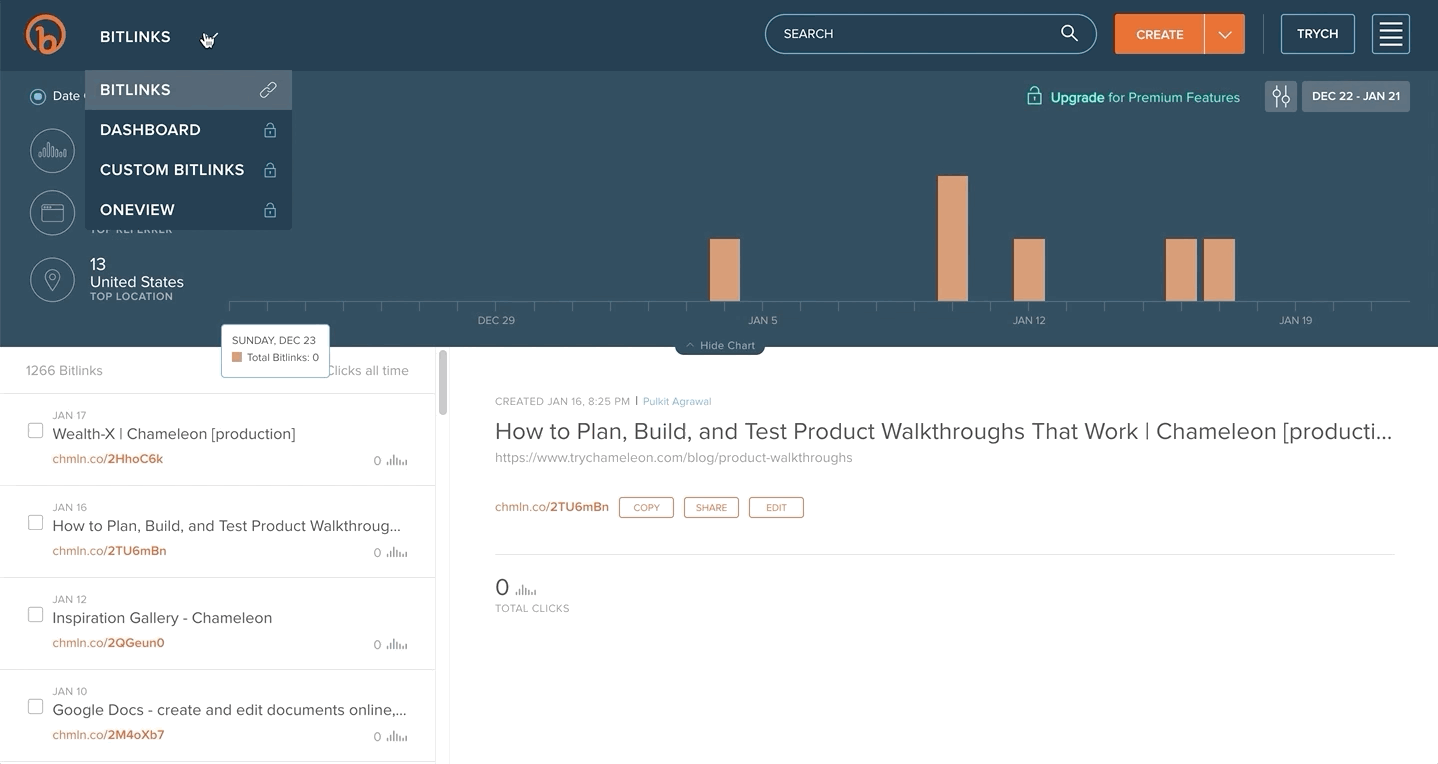In Heap's cosy office, Chameleon CEO Pulkit chats with David Saxon about current trends in product-led growth, customer data and SaaS integration.
We talk about how Heap and Chameleon's integration can help teams drive product growth by providing a way to quickly measure UX impact, and about waking up at ridiculous hours to catch international sports games.
Watch the video below, and keep reading for the transcript and more on how Heap and Chameleon help you unlock user insights and drive product adoption.
How Customer Data Powers Product-Led Growth
David Saxon (DS): Hi, this is David Saxon with Heap, the VP of partnerships and we have here today with us, Pulkit Agrawal, who's the CEO of Chameleon, and welcome to the show.
Pulkit Agrawal (PA): Thanks. It's a very comfortable setting. So happy to be here. Can talk for hours like this.
DS: Perfect. Perfect. Well first Pulkit, why don't you tell us a little bit about Chameleon?
PA: Yeah, absolutely. So Chameleon is a platform for product growth. Now what that means is that when users are using any software, they may need a little bit of guidance or help or encouragement to take certain actions that will help them discover value and succeed. Typically, it's really hard for teams to prioritize building those versus building core features.
There's always that tension in teams of what do we build? Do we need to build new functionality or do we need to improve the user experience?
Chameleon helps teams create and deliver in-product experiences that help users take action. So great use cases include user onboarding. If you need to help a user take some actions when they're brand new to the product, or for feature launches and announcements, if you want to reduce churn and drive adoption of new functionality, or if you want to deflect support tickets by pointing out certain aspects of the interface. Chameleon allows you to do all of that without writing any code.
DS: So you must consume a lot of data and everything about that. Love to hear a little bit more about that. How that incorporates into kind of the whole solution.
PA: Yeah, absolutely. So for us, there's kind of two levels of data. Of course, as a SaaS company we have to think about our product's usage and data associated with how our customers are using Chameleon to build these product tours. And then we have a second level of data, which is looking at how our customers' tours are performing with their end users.

How Customer Data Powers Product-Led Growth
When, for example, a customer builds a user onboarding tour with Chameleon, we need to be able to track and then relay to them how successful that tour is. So how many of their end users started it, saw various steps, took certain actions and then completed or exited.
We're in this great position where we have to do a bunch of data analysis for our own product, but also help and support our customers do data analysis so that they understand how the things that they've created are performing.

Optimize the entire user journey
Deploy in-app campaigns that convert with Heap and Chameleon. Get visibility over how tours impact every KPI that matters 📊
How Customer Data Powers Product-Led Growth
DS: We were talking about this earlier, just the trends that we're seeing in the marketplace, right? As kind of like digital is becoming more dominant within the enterprise and even small and medium sized companies, many different applications internally, externally. Love to get your perspective on kind of the industry and where you see things going, and how people are interacting with that internally.
PA: Yeah, absolutely. I think, a couple of trends that come to mind, there is this one aspect which is that everything is becoming product first. So it's becoming more and more important for products to be good at what they say they will be good at.
Buyers are no longer just relying on non-product experiences, whether that's the website or emails or in-person communications. A lot of that is flowing into product. (tweet this)
A concrete example is that to help scale sales, more and more products or having free trials instead of just demos. So you can actually evaluate the product as part of the purchasing process.
PA: For example, with marketing, it's not all about the website, and launches with blog posts. You need to start having in-product marketing for the existing user base. Because if you're not actually communicating with your users where they are, then how are most of your valuable, important customers going to learn?
That's the case for marketing coming into the product. We've seen that with support and success, with live chat inside of the product, so users can get access to support information right when they're doing something.
PA: We're seeing this trend where every team within companies wants access to the product and wants to communicate with their users through the product. And so that means that data becomes more important and it needs to be accessible for more people.
It can't just be the remit of a product or engineering or growth team. We need account managers and customer success managers and others to know what's going on in the product and then eventually be able to take action based on those things.
If [the CS team is] seeing that a user's tripping up somewhere because they don't understand some terminology, they need to be able to easily create something and deploy that.
PA: And that's another trend that we're seeing is more and more abstraction of tasks that used to be all done in-house with engineering teams being run by SaaS software, because engineering is a big bottleneck and they can't be relied on for everything.
Really, engineering teams should focus on the core competencies and the real differentiators. So those are some of the kind of the trends that I'm seeing. And I'm definitely interested by, in terms of how that shapes how teams use data, how teams create product experiences, and even how teams are re-organized within companies.
DS: It's interesting to see that evolution kind of over the last five to 10 years of all these different contingencies internally are hungry for data and winning access to that data. And they're given the tools to get access to that data. There's people who were literally lines of business and product marketing or etc. in different divisions, finance, what have you, having to be more data savvy about their knowledge of the data that's being collected and what to do with it to make their job a lot easier. Right?
PA: Yeah, and I think we're seeing some great progress around automating the friction points. I mean, Heap does a great job around automating the instrumentation of data, because we don't want to get tripped up on those pieces and stuff like that really prevents data been used effectively.
I think where possible we need to simplify those tasks that get caught up in engineering bottlenecks and really let data bloom within an organization so that they can leverage it to create really great user experiences and to provide a ton of value to their customers and users.

How Customer Data Powers Product-Led Growth
DS: Let's talk about the partnership and the value of Chameleon and Heap. Love to get your perspective on it.
PA: Yeah, I think we're natural partners because we both have very similar philosophy, which is how can we empower non-engineering teams, or other teams across the organization, to make use of data and product experiences? So how can we minimize the amount of effort placed on engineering to do this?
With Heap's automatic event tracking and then Chameleon being able to build and deploy these in-product experiences without writing any code, there's kind of a natural alliance around the philosophy and approach.
I think there's also a natural partnership because when customers are using Chameleon to build product tours, they need to rely on an understanding of the product and what's happening.
For example, let's think of a team trying to drive up sales from a silver plan to a gold plan. Now they know if a customer is using it on a silver plan and takes an action where they're using some advanced functionality, there's a really good potential that they might find value in the gold plan.
What they can do is understand which customers are using on the silver plan and which customers have taken event through Heap, send that data to Chameleon and then create an experience where inside of the product those customers or users can be shown some upsell modal, or some banner that explains the value of the gold plan. Then when the user interacts with that, that data will go back into Heap, so you can analyze how that experience behaved and performed.

How Customer Data Powers Product-Led Growth
PA: So we're really closing the loop between understanding what's happening in the product, being able to act on that data and then evaluating how that action performed to help iterate and drive towards a success. So that's kind of the basis of the partnership.
DS: Yeah. Yeah, that's great. And it makes it ... It's a more iterative approach to really building applications more centered around the user as well. Since we're a user-centered data collection mechanism and you guys are really focused on creating better user experiences, it's a great partnership.
PA: Yeah, absolutely. And I think more and more so, we are evolving into this world where everything's happening continuously. Everything is very agile.
Now, at least in Silicon Valley or San Francisco where we are, it's almost the norm to be able to do things iteratively and be able to tweak and experiment and change rather than run big projects to do something and then come back to it a long time later. So I think it fits nicely in that same trend.
DS: Another question I'll ask you is that from your accent, I can tell you're not from the Bay area. So it seems like you are from the UK, correct?
PA: That's right.
DS: Yeah, and a big football fan, or as we say, soccer here in the US.
PA: Yeah, we'll say football. Big football fan. Support Liverpool. I'll give a shout-out to them and excited to follow them. I end up waking up pretty early on Saturday mornings to catch the 3:00 PM kickoffs. The eight hour time difference doesn't help, but it's much worse when it's a lunchtime kickoff and I'm up at 4:30 to watch a game. But yeah, it's fun to follow.
Want a stack that enables you to measure and optimize how in-product feature launches, upsells, and onboarding tours impact the full user journey? Get in touch to learn more about Chameleon and Heap.



